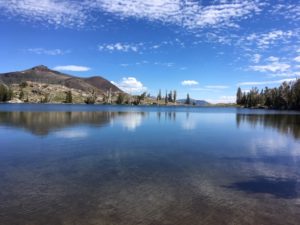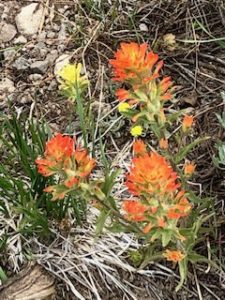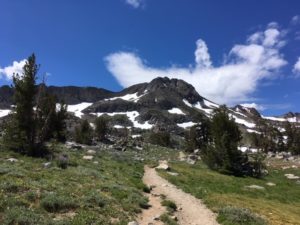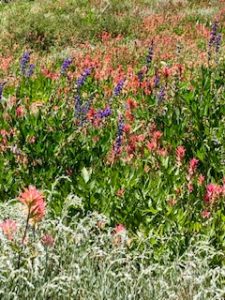
Winnemucca Lake, Alpine County, California. Photo by Catharine Norton
What, a place in California where there are hardly any people — and yet is so strikingly beautiful that it’s been called the Switzerland of California?
OK, I’ll ‘fess up — I’m the one who called it the Switzerland of California, as I hiked recently along a mountain trail bordering meadows blanketed with wildflowers and sporting gorgeous views of 11,000-foot peaks that still displayed pockets of snow in early August.
And its very name — Alpine County — certainly evokes Switzerland as well, as does its semi-official nickname, the “California Alps.”
The area was first explored by non-native Americans when John C. Fremont and his scout, Kit Carson, passed through in 1844. Soon after came contingents of Mormon settlers and gold prospectors, and much later still vacationers and second-home owners.
Alpine County isn’t very large — it’s the eighth smallest county in California — but its 726 square miles swallows up its population of some 1,100-plus residents (less than two per square mile), who are scattered among a few small towns nestled in the valleys (charmingly named Faith, Hope, and Charity) amid the Sierra Nevada range.
The entire county stands at high elevation, ranging from 4,800 feet to 11,400 feet. Consistent with being California’s most sparsely populated county, only about four percent of Alpine’s land is privately owned; much of it is national forest, and stately Jeffrey and Ponderosa pine trees line the roadways, some of which are impassable in winter due to heavy snows.
This summer, the highest elevation passes didn’t open until July — just in time for the aptly named annual “Death Ride,” in which cyclists compete to see who can bike up and down over a series of mountain passes on a 129-mile course that requires climbing some 15,000 vertical feet. (No reports on how many riders have actually survived.)
Markleeville: Hot Springs and Hot Times
My wife, Catharine, and I were week-long guests of friends from the Bay Area who have a cabin in Markleeville (population 200, elevation 5,500 feet), a riverside community about 30 miles southeast of South Lake Tahoe and a world apart.
Markleeville is the Alpine County seat and is named for a man, Jacob Marklee, who was shot to death in 1863 two years after staking a claim in the area, “a victim of his own hot temper,” as the local Chamber of Commerce puts it. The man who shot him over a land dispute was acquitted of murder, but Marklee got the marquee.

Wildflowers along the trail. Photo by Sheldon Clark
Marklee may or may not have been buried in a small 1860s-era cemetery on a ridge overlooking the town, though the local historical society has spruced up its Historic Cemetery Trail just in case.
Even higher up on another ridge is the Alpine County Museum Historical Complex, which, while only sporadically open, is worth a drive up the hill. Besides nice views of the region, the complex includes the Old Log Jail, the Old Webster Schoolhouse, and various other Old Things — complemented, to be sure, by a newish gift shop.
But Markleeville is not known just for history. Its top attraction is Grover Hot Springs State Park, located in a sylvan meadow a few miles outside town.
Besides some easy-to-moderate hiking trails — highlighted by a new boardwalk through the meadow — and a tree-shaded campground, the park draws an international crowd to its celebrated hot springs, featuring a large swimming pool filled with natural 100-plus-degree water that flows from the Sierra. A “cool pool” is adjacent in case the hot pool gets too toasty. It costs $10 a person and you can linger for hours if you want.
Food and Lodging
Markleeville also features a very nice restaurant on its main street called the Stonefly, unfortunately open only on weekends. Inventive wood-fired pizzas, yummy appetizers like mushrooms on polenta, and main courses such as ribeye steaks and sea scallops make it the local culinary star. Its spacious outdoor patio fills up quickly on warm nights, though, so reservations are strongly advised.
There are a few more casual places about for grabbing meals, but it’s also worth the 25-minute drive to Gardnerville, Nevada, to have dinner at the venerable J.T. Basque restaurant, where you’ll be served multiple courses, only one of which you have to order yourself.
Between tasty soups and desserts come savory stews, beans, some of the best French fries on the planet — all served family style in bowls or on platters — as well as your personal choice from a variety of main dishes, heavy on the meat. (Vegetarians may want to skip this trip.) And oh yes, a delicious young red wine is included as well.

Snow still dots the high mountains. Photo by Catharine Norton
Back in Markleeville and environs, you’ll need accommodation (unless you are camping — available by reservation in state parks and free on all national forest lands — or camping out in our friends’ loft as we did).
You can try the Creekside Lodge (888-802-7335) in town, or the Woodfords Inn six miles down the road, but I like Sorensen’s Resort, somewhat farther away in a forested spot on the edge of Hope Valley and a longtime gem featuring log cabins, cottages, and a restaurant serving three meals a day.
You can also venture clear to the county line and bunk at Kirkwood Mountain Resort, best known as a winter ski/boarding resort but which stays open year-round as a full-service lodge.
Hiking and Other Outdoor Action
Assuming you aren’t going to Alpine County for the Death Ride — a true bucket list item — you may well want to take advantage of the area’s excellent hiking, fishing, horseback riding, and wintertime skiing. Or, if you hail from Minnesota — as our friend and host Veronica originally did — and find 40-degree water temperatures refreshing, you can even go swimming in the many lakes.
Scenic drives are also a must, especially since you can’t avoid sweeping vistas even if you wanted to. Well paved highways curve up mountain passes that overlook serene lakes, deep valleys, and towering peaks.
At one point we passed a sign marking the barely visible remnants — now mostly thick forest — of once-thriving Silver Mountain City, an 1860s boomtown that sprang up on promises of silver and gold, then just as quickly went bust when extracting the minerals from the mountains proved too difficult and costly. At the time, the population of Alpine County actually exceeded that of today’s, before the prospectors moved farther west to what became known as California’s Gold Country.
In the spirit of the Old West, where comfort must have been a dirty word, we sampled some four-wheel-drive-only “roads” that led to isolated mountain lakes and meadows.

Wildflowers bloom late at 9,000 feet. Photo by Sheldon Clark
Reaching our goal of Burnside Lake required venturing along miles of glorified donkey paths that tested even those passengers with bladders of steel. Apparently mine is more like tin foil, but I persevered as our undaunted driver, Shelly (Veronica’s husband and our co-host), resolutely forged on. I may have suggested turning around a time or two, as Shelly contends, but I’m sure I didn’t ask “Are we there yet?” all that many times.
Another, shorter donkey path led to Cow Camp, a hillside meadow that was alive with wildflowers bursting with color: Indian paintbrushes, corn lillies, wild irises, lupines, scarlet gilias, Alpine shooting stars, asters, rangers’ buttons, and monument plants, to name a few.
A walking trail led up the hillside right through the heart of the meadow. That excursion was more than worth the bumpy ride, as were our two stints at Kirkwood Lake, where avid-angler Shelly fished while the rest of us followed a nice wooded trail encircling the lake. Veronica then took a dip in the icy waters, offering further proof that she and Shelly are perfectly matched for Alpine County.
But the highlight of the week was a five-mile hike stretching from 8,000-foot-high Carson Pass up to 9,000-foot-high Winnemucca Lake, and then down to a lower lake, where other friends were waiting with snacks and a car to shuttle us back.
This is the hike that reminded me of Switzerland. Along the way, the wildflowers, mountains, and lakes were stunning, the air fresh and clean, some excited kids reveled in throwing snowballs in August, and I could temporarily forget Tucson’s stifling summer heat.
Yodeling is optional.












Leave a Reply